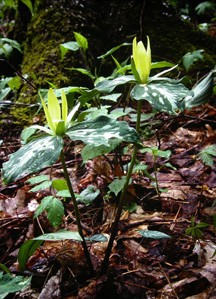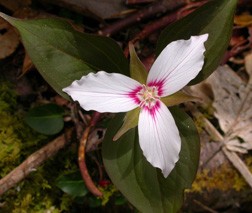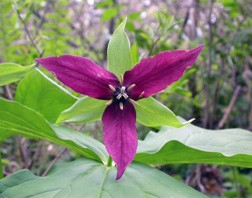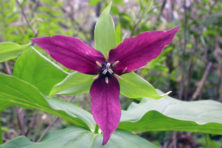Trilliums – Door County and Blue Ridge Mountains
- Share
- Tweet
- Pin
- Share
It was during the last week of April 1975, 38 years ago, that the lure of the mountains activated the gypsy blood in our veins as Charlotte and I headed toward a dream come true, a trip to the Great Smoky Mountain National Park.

The Yellow Trillium is very common in the Smoky Mountain National Park and is widely known to trillium aficionados.
Ever since reading Edwin Way Teale’s book, North with the Spring, I had wanted to kick our cold, fussy April in the pants and head for the Smokies to experience Madam Spring at her finest a month ahead of our time.
The awesome Smokies surely did live up to and easily surpass our greatest expectations. What a botanist’s paradise it is, a profusion of contrasts, and a fantastic place to get a head start on the parade of wildflower blooming. I was so impressed with what we had thoroughly enjoyed that it prompted me a year later to initiate an annual Wildflower Pilgrimage at the Ridges Sanctuary. In later years this was expanded and called the Festival of Nature.
This past April 18, Charlotte and I, along with our friend Paul Sterrenberg, left on a 10-day whirlwind trip to visit our friends Laura and Don Just,who live near Blowing Rock in the western portion of North Carolina. Their home is situated along the steep southern slope near the famous Grandfather Mountain, the tallest peak in the Blue Ridge Mountains. The precipitous wooded terrain and sharply curving roads led us to plenty of wonderful waterfalls and streams bordered by unusually fine wildflower displays.
Highly fragrant Foam Flowers seemed to be everywhere, along with Trailing Arbutus, Partridgeberry, Bishop’s Caps, Great Chickweed, several species of violets, Bluets, Fire Pink, Crested Iris, Christmas Ferns nearly at every footstep, and several species of trilliums that soon took “front and center stage.”

The so-called Whip-poor-Will, or Large Toadshade, is the largest of the eastern sessile trilliums, those having their tightly clustered petals facing upwards.
Either the season wasn’t quite right or the elevation too high for the flowering of Trillium luteum, usually called the Yellow Trillium or Yellow Toadshade by the locals in that area, but we did manage to see a few. Charlotte and I encountered and photographed many in our camping adventure at the Smokies in 1975. How appropriate it is that the Yellow Trillium has a strong lemon odor!
Some of my information about this trillium species and others has been gleaned from reading Trilliums, written by Frederick W. and Roberta B. Case from Saginaw, Mich. All 38 species of North American trilliums are thoroughly examined, along with stunning colored photographs in this scholarly and award-winning book.
As it turns out, the use by rock gardeners and the flowers’ availability has led to more people recognizing the Yellow Trillium than any other sessile species. Many trilliums in general are quite easy to grow, are available from qualified growers, and have become great favorites of flower gardeners worldwide. The fact that there are no trilliums native to Europe has made them top favorites there, where these special wildflowers demand very high prices.
The next of the sessile trilliums (petals upright and attached to another organ without a stalk) we came upon was Trillium cuneatum (coon-e-A-tum), a wildflower that has been given fascinating names by people of the Blue Ridge Mountains, such as Whip-poor-Will, Large Toadshade, Bloody Butcher and Sweet Betsy. Its species name means “wedge-shaped,” referring to the tapered shape of the basal half of the petals. This is the largest of the eastern sessile trilliums.

The Painted Trillium ranks high on the list of favorites among wildflower enthusiasts.
What a thrilling discovery it was to come upon our very first Painted Trilliums, also called the Striped Wake-Robin and the Painted Lady. Its scientific name is Trillium undulatum (un-dew-LAY-tum) referring to the distinctive undulating wavy edges on the petals. Mother Nature has very skillfully painted bright red near the base of all three of the petals where they converge. Unlike our widespread expanses of the Large-flowered Trilliums in Door County and elsewhere in Wisconsin, this dazzling beauty seldom forms large clumps but, rather, will be seen as scattered individuals wherever its fussy habitat occurs. We had our best experiences with them on our way home at the never-to-be-forgotten Joyce Kilmer Memorial Forest in extreme western North Carolina. (This will be a topic for another story.)
Our friend, Don Just, is the well-loved pastor at the St. Marks ELCA Lutheran Church south of Blowing Rock, and it was there that we had the chance to converse with several of the mountain-born-and-raised parishioners. How we loved their speech, their friendliness and hominess. We could easily expect some of the unusual names for the next trillium species we came upon, the Red Trillium, Trillium erectum (e-REK-tum). Some of the favorite mountaineer names include Wake-robin, Purple Trillium, American True Love, Birthwort and Stinking Benjamin. The “stinking” name stems from its unpleasant odor when smelled from close range, but why it applies to Benjamin, we don’t know.
We were fortunate to see both the dazzling red form and the more subdued maroon of this very widespread species, which is also known for its many subtle varieties. What makes this plant such a delight for wildflower aficionados are its habits of being among the first wildflower species to bloom and its tendency to form large eye-catching patches.

The flashy Red Trillium, also called Stinking Benjamin, is an eye-catcher.
I write this story on April 30, having arrived home from the Blue Ridge Mountains two days before, and to my great joy discovered about two dozen Large-flowered Trilliums well protected in the small retaining-wall alcove on the west side of our house. Even though the plants are of fairly small stature they are in full bud and ready to open within the next day or two. They are always the forerunners of what eventually will be about eight or nine acres of our hardwoods virtually carpeted in white with tens of thousands of the showy Large-flowered Trilliums in full bloom. It is thought that this trillium is the most showy, best known and loved of all trilliums in North America.
Only one state, Ohio, has chosen a trillium to be its state flower, the Large-flowered Trillium, Trillium grandiflorum. Naturally our state wildflower is the common and widespread purple Wood Violet, chosen quite a few years ago by Wisconsin school children.
We Door Countyites are fortunate to have a second species of trillium, the Nodding Trillium, Trillium cernuum (SERN-you-um). The species name of cernuum means nodding, in allusion to the plant’s drooping blossom, occasionally dangling straight downward and presenting a challenge to locate the plants.
Prepare yourself for the parade of trilliums, rightfully considered to be the most wonderful wildflower genus in North America. A trip to the Blue Ridge Mountains will surely help sell you on this widely held belief!

